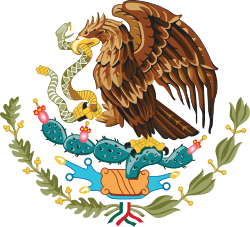Mexico 68
| Mexico 68 | |
|---|---|
| Part of the Protests of 1968 | |
 Armored cars at the "Zócalo" in Mexico City in 1968 | |
| Date | 1968 |
| Location | Mexico |
| Causes | |
| Result | Start of the Dirty War |
Part of a series on the |
|---|
| History of Mexico |
 |
|
Spanish rule |
| Timeline |
|
|
The Mexican Student Movement of 1968 was a student movement caused by an ideological clash between generations. Socialism and Capitalism also influenced the students and the government at that time. October 2 and the Silence March are the most important parts of the movement. Students from the IPN, UNAM and other schools forgot their differences and acted as one to achieve their goals. The 1968 Summer Olympics played an important role on the way the government acted. Both the government and the students acted according to their generational ideologies. This movement was influenced by the world’s movements at that time, like the Hippie movement. The movement influenced Mexican feminism and women played an important role in it. The events that happened from July–October 1968 are colloquially called Mexico 68.[1]
Context
The world
See: Columbia University protests of 1968
During this time, the Vietnam War caused an ideological revolution around the world. With the introduction of The Pill, sexual liberation arose giving momentum to Mexico. Also, the hippie movement gave place to a "peace and love" ideology, adopted by students worldwide who tried to extend it throughout society.[2] These were some of the reasons why many student movements took place around the globe, showing young people's dissatisfaction with the social situation.[1] [3]
Mexico
Social
There was an ideological clash between older adults and younger adults, caused by the differences between the generations to which they belonged. The newer generations were open-minded toward innovations and believed in a bright future, while the previous generations found themselves unprepared to accept all the new ideas. Because of this ideological clash, the new generation was repressed by the previous one, which resulted in the formation of young adult movements.
Political
The government restricted citizens' freedom of speech and action. This caused them to live a more pacified life in some ways. However, people got tired of this lifestyle, becoming discontent and dissatisfied with their government. Mexico, like the rest of the world, was dealing with the clash of two ideologies, socialism and capitalism, which gave place to internal conflicts. According to the Constitution, the government had the right to use military force in order to maintain peace in the country.[1][2]
Olympic Games
The 1968 Olympic Games took place in Mexico, making it the first developing country to host this event. This represented an important source of income to the country because of the tourists who would come to attend the Olympics. Giving a good impression to the world could lead to the introduction of international investors. However the students were against these ideals. They did not believe that the appearance of Mexico to the world was a priority. They preferred a revolution resulting in the reformation of their country. "No queremos Olimpiadas, queremos revolución" (We do not want Olympic Games, we want a revolution).[3] The IOC threatened to move the Games to Los Angeles if the situation deteriorated.[1]
The Movement
Purpose
With all these repressions and constant injustices going on in the country, the younger generations decided to take justice into their own hands. Beginning in July 1968, many students' movements started to arise. Young adults, especially university students, tried to find a place for themselves due to the general repression of society, becoming attracted to what was considered socially unacceptable.[3] The purpose of many of these students' movements was to show their dissatisfaction with their society, trying to create a better world or a place to call home. This discomfort was heightened by the influence of music worldwide such as The Beatles and The Rolling Stones, which many young adults identified with.[1][2]
Tlatelolco massacre
From July to September 1968, student movements started to arise and become stronger and more violent, to the point that the government stepped in. However, these meetings were usually under control, until October 2, 1968. At 5 PM in the Plaza de las Tres Culturas in Tlatelolco, a neighborhood of Mexico City, almost 10 thousand men, women and children stood waiting for a meeting to start. However, when the leaders of the several student organizations and movements arrived, policemen and the military, sent by president Díaz Ordaz and commanded by Luis Echeverria, decided to dissolve the meeting. A student claims that at about 6:10 a helicopter dropped three flares over the plaza, quickly followed by the first gunshots.[4][5]
Role of women
Women played an important role in the movement of Mexico 68. According to Elaine Carey, the female participants in the movement lived through an intense social experience and a sudden expansion of their expectations as citizens and as women. Many women awakened to the political and social commitment that had made. Before the repression of the initial demonstration, there were already some student groups that gave women the opportunity to participate actively in the social movement. Because of this increase in societal influence, feminist ideas started to spread and grow stronger. At the time, government officials tended to focus on the men in the movement, discounting the significance of the role played by women. As a result of this discrimination, men became the government's primary target during the crackdown at Tlatelolco on October 2, 1968. This gave female members the opportunity to keep the movement alive, determining its direction in the ensuing years.[6] One of the most important feminist groups was “Las Panchas Pomposas.”[6]
Marta Lamas, one of the most prominent representatives of Mexican feminism, gave women the opportunity to participate in Mexican movements. In the early years of the following decade, the Liberation of Women Movement, Women in Action Association and the National Women's Movement, among other organizations, were created.[7]
Rosario Castellanos covered a domestic women's strike in the United States in the name of feminism. She used the strike as an example in order to question concepts of Mexican femininity. With these actions, Rosario Castellanos opened the door to more discussion concerning feminism.[6]
Carmen Landa showed by her own example how changes have been made and how the feminist movement could change lives. This introduction to feminism in 1968 led her to become part of this movement.[6]
These are some examples of women in the movement, however, there were many more like Alejandra Herrera, Vida Valero, Mercedes Perelló, among many others.[6]
Consequences
This social movement brought unavoidable consequences which permanently changed the future of Mexico,[1] but these political and social changes were not immediate, the repression continued with the Corpus Christi massacre in 1971.
The major change caused by this movement came at a political level. The citizens had the opportunity to live a new democracy in which their opinion could actually bring change in society. People no longer trusted completely in the government and would no longer live completely under the conscious control of their government, nor tolerate it anymore,[4] although they were not completely free. Octavio Paz resigned from the Indian embassy as an act of protest against the government's harsh repression of the student movements. However, there were also some older intellectuals who were in favor of the government, like Agustín Yañez.[3]
Several social changes took place after this year. No longer would people have to live under strict and unbreakable rules. Because of this, there was more freedom of action under the law as well as freedom of expression without prior restrictions.[4] New ideas were formed and transformed daily life. The new feminist ideology allowed women to fight for their rights, increasing the social participation of women by a significant percentage. Women no longer only had to take care of the house and children, but could also become business women.[6]
Notes
- 1 2 3 4 5 6 Xypolia, Ilia (2013). Gokay, Bulent; Xypolia, Ilia, eds. "Turmoils and Economic Miracles: Turkey '13 and Mexico '68" (PDF). Keele, UK: Keele European Research Centre. p. 33.
- 1 2 3 Castro, Genoveva; Blanco, R.; Lasso, C.; Rodríguez, I. "Cronología del movimiento estudiantil de 1968". RedEscolar. Retrieved 2011-10-16.
- 1 2 3 4 Ponitowska, Elena (September 1998). "Son cuerpos, señor…". Equis. pp. 3–8.
- 1 2 3 González, Víctor M. (June 2003). "México 1968…¡No se olvida!". Instituto Tecnológico y de Estudios Superiores de Occidente. Archived from the original on November 3, 2007. Retrieved 2007-11-07.
- ↑ Youtube footage in which flare drop is visible. Footage was recorded secretly by the government on the day of the massacre. See: Radiodiaries.org
- 1 2 3 4 5 6 Carey, Elaine (2005). Plaza of Sacrifices: gender, power and terror in 1968 Mexico. USA: Editorial Dialogos. ISBN 0-8263-3545-4.
- ↑ Soto, Cecilia (1998-11-11). "Las mujeres y el 68". Reforma. p. 18.
References
- Pérez, Javier; H. Magaña (February 2003). "Los Movimientos Estudiantiles en México". FES Zaragoza-UNAM. Retrieved 2007-11-07.
